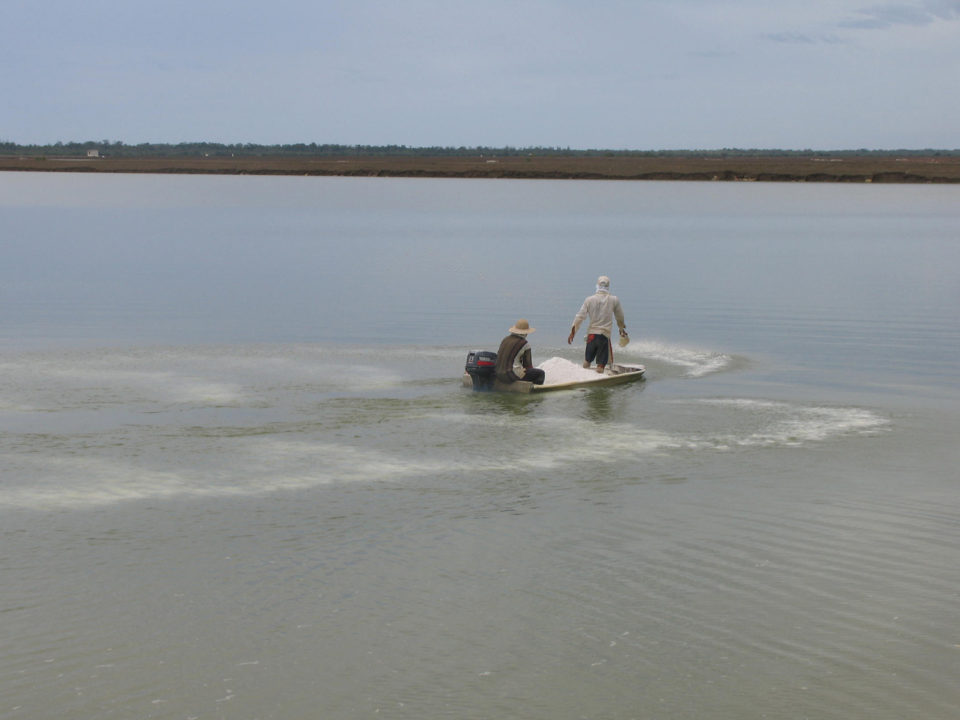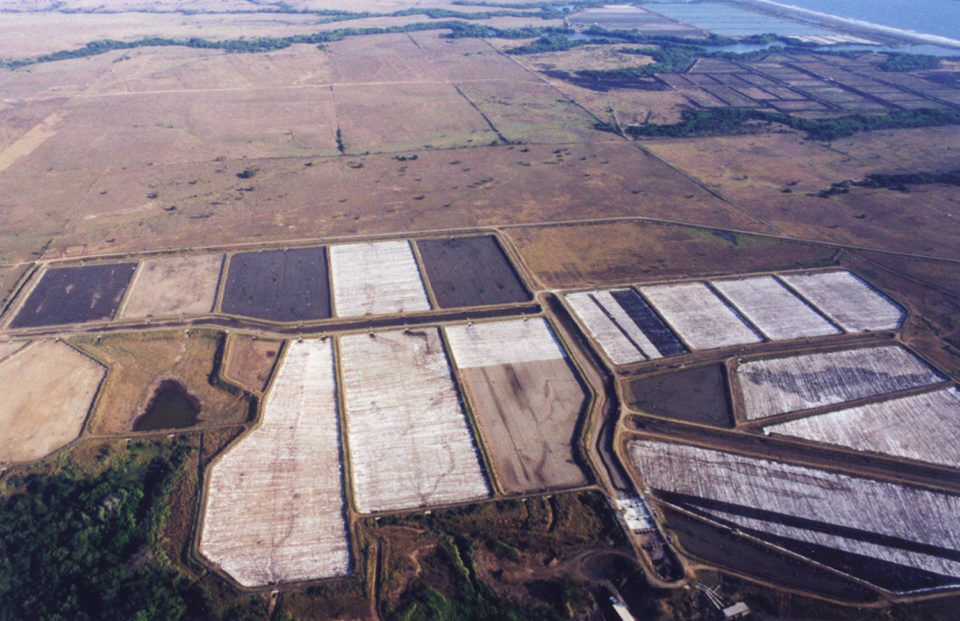Prof. Boyd explains the basic reactions of this widely used practice

Application of agricultural limestone to improve pH and alkalinity in aquaculture ponds is a widely used practice. However, there is considerable use of lime in aquaculture to disinfect pond bottoms and water, to attempt to control pH and various other reasons. Here I explain the basic reactions of lime added to ponds.
Types of lime
There are two types of lime – burnt lime and hydrated lime. Burnt lime is made by heating limestone at high temperature in a furnace to drive carbon dioxide from the limestone and produce an oxide. Limestone is calcium carbonate (CaCO3) or a mixture of calcium carbonate and magnesium carbonate (MgCO3), so burnt lime is calcium oxide (CaO) or a mixture of calcium oxide and magnesium oxide (MgO). Burnt lime also is called unslaked lime or quick lime. Burnt lime can be treated with water to provide hydrated lime which is calcium hydroxide [Ca(OH)2] or a mixture of calcium hydroxide and magnesium hydroxide [Mg(OH)2]. This product is called hydrated lime, slaked lime or builders lime. Both burnt and hydrated lime are used in aquaculture.
Reactions with water
Burnt lime, which will be represented here as calcium oxide, reacts with water to form calcium hydroxide rather than dissolving in the usual sense. The reaction is:
CaO + H2O –> Ca(OH)2.
The reaction of burnt lime and water releases considerable heat; thus, calcium oxide reacts faster at lower temperature than at higher temperatures.
Farmers realize that calcium oxide releases heat, because they have observed this phenomenon when mixing it with water. This observation has led to the common belief that liming increases water temperature in aquaculture ponds. Technically, this is true, because each kilogram of calcium oxide that reacts with water releases 272.6 kilocalories of heat. One kilocalorie will raise the temperature of 1 L water by 1 degree-C. Application rates for burnt lime usually are 50 kg/ha or less. Suppose that 50 kg of burnt lime are added to a 5,000 m2 by 1.5 m deep pond (7,500,000 L). Assuming that the lime reacts completely with water, 13,630 kilocalories of heat would be released. The temperature of the pond water would increase by 0.0018 degrees-C – an insignificant amount.
In the industrial production of hydrated lime, the heat from the reaction of burnt lime and water is released. Thus, hydrated lime does not release appreciable heat when it dissolves in water.
Each kilogram of calcium oxide equates to 1.32 kg calcium hydroxide. The solubility of calcium hydroxide is about 0.12 g/100 mL (1,200 mg/L) at 30 degrees-C. Thus, for practical purposes, the solubility of calcium oxide at 30 degrees-C is about 900 mg/L.
Calcium hydroxide – either from the reaction of calcium oxide and water or from direct application of calcium hydroxide – dissociates into ions:
Ca(OH)2 ⇌ Ca2+ + 2OH–.

Usage in ponds
The hydroxide ion (OH–) causes pH to increase. For example, water saturated with calcium hydroxide would have a hydroxide concentration of 0.032 molar and a pH of about 12.5. A pond of 7,500,000 L volume to which 50 kg of calcium oxide (equivalent to 66 kg calcium hydroxide) was added – assuming a complete reaction with water – would have a hydroxide concentration around 0.0040 M and a pH of about 11.6. A treatment as low as 10 kg of calcium oxide (13.2 kg calcium hydroxide) would increase the pH of the pond to around 10.9. The high pH resulting from the reaction of lime in water is the reason that this material often is recommended as a pond soil or water disinfectant.
Lime often is applied in small doses and at frequent intervals to shrimp ponds in attempts to regulate phytoplankton abundance and pH. Lime increases pH and calcium concentration favoring the removal of phosphate from the water. Raising the pH also removes carbon dioxide from the water. Less carbon dioxide and phosphate are thought to limit phytoplankton photosynthesis and avoid wide daily shifts in pH.
There is a danger in killing shrimp or fish when either burnt or hydrated lime are applied to ponds during the culture period. However, during pond applications, some of the lime settles to the bottom without dissolving or reacting. The hydroxide resulting from the portion of the lime that dissolves reacts with carbon dioxide in the water becoming bicarbonate. Usually, at least 50 kg/ha of calcium hydroxide (equal to 38 kg/ha calcium oxide) can be applied to ponds without causing a dangerously high pH. The effectiveness of lime on stabilizing pH has not been verified despite the wide use of lime in shrimp ponds for this purpose.
Hydroxide imparts alkalinity to water, and each milligram per liter of calcium hydroxide that dissolves in water increases alkalinity by 1.35 mg/L. Of course, if all the hydroxide is converted to bicarbonate through reaction with carbon dioxide, the alkalinity increase will remain 1.35 mg/L for each milligram per liter of calcium hydroxide initially applied – at least initially. The alkalinity increase, however, is controlled by pH and calcium concentration. There is a calcium carbonate saturation pH, and if the pond water pH rises above pH for calcium carbonate saturation, calcium carbonate will precipitate from water. This puts a limit on the solubility of burnt and hydrated lime, and agriculture limestone also.
Seawater usually is at or near saturation with calcium carbonate. As a result, liming materials usually will not dissolve in shrimp ponds. Huge quantities of liming materials are applied to shrimp ponds. In many ponds, these materials do not dissolve and merely settle to the bottom.

Lime also may be applied to the bottoms of ponds between crops for the purpose of increasing pH and killing unwanted organisms including vectors of disease. Studies have shown that 3,000 to 5,000 kg/ha of hydrated lime (2,300 to 3,800 kg/ha of burnt lime) must be applied to soil to increase pH above 11 for at least 12 hours. The soil pH falls rapidly following application as the hydroxide ion from lime application reacts with carbon dioxide. Also, in acidic soil, the pH falls as lime reacts with soil acidity. This increases soil pH, but it causes the initial high pH resulting from hydroxyl ion to fall quickly to a level too low to kill unwanted organisms. Farmers seldom use over 500-1,000 kg/ha, and most lime treatments to disinfect pond bottoms are ineffective.
Lime is a worker safety hazard because of its causticity. When working with lime, one should wear clothing that covers their entire arms and legs, gloves, protective glasses and a dust mask. The author personally knows an aquaculturist who lost his sight in one eye because a lime solution splashed into his face.
Author
-

Claude E. Boyd, Ph.D.
School of Fisheries, Aquaculture and Aquatic Sciences
Auburn University
Auburn, AL 36830 USA
Tagged With
Related Posts

Responsibility
Calcium and magnesium use in aquaculture
Aquatic plants and animals get the essential nutrients calcium and magnesium from water and food. Calcium concentrations impact the hydration and development of eggs in a hatchery, where calcium carbonate precipitation can be troublesome.

Health & Welfare
Decomposition and accumulation of organic matter in ponds
Aquaculture ponds accumulate organic matter from organic fertilizer, remains of microorganisms produced within the pond, feces of the culture animals and uneaten feed. Claude E. Boyd, Ph.D., details the leading organic matter management practices, and says that the accumulation of organic matter is often not as great as believed.

Responsibility
Reviewing the ‘near-magical’ properties of water
Understanding the hydrologic cycle, water’s unique physical properties and their behavior in aquaculture systems – phases, humidity, saturation, stratification, light reflection and refraction – is pertinent to properly manage water quality in production systems, according to world-renowned expert Dr. Claude Boyd.

Responsibility
The importance of liming materials in aquaculture
Liming is an important management tool for preparing aquaculture ponds between and during production cycles. Several products are sometimes used in aquaculture for liming production ponds, including agricultural limestone, calcium silicate (CaSiO3) and sodium bicarbonate (NaHCO3).

